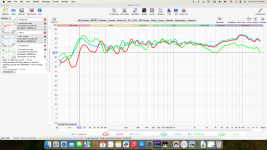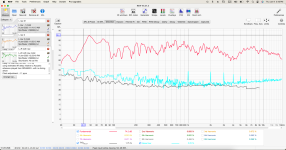I like to follow the rules or instructions for braking a Mark Audio driver in. I have never over the years had any issues or blow outs in my drivers playing. Same goes for the fostex drivers no issues at all or the Tang Band drivers. I can’t afford to blow drivers. The only drivers I had issues with is the first production of the Common sense Audio 8’s. After hooking the driver up and playing on very low volumes (I could hear but, the cone was moving). Philip Glass they had a very odd rubbing noise? I had 3 drivers and they all did that sound. So I sent them back and got my money back. Hooked up to the fostex FE206E driver’s same room no problems. I just remember.🤔. I have replaced a few Mark Audio drivers the CHN-50’s (due to driving a screw in and the drill slips and puts a hole in the driver 😱🤯😩). I messed up 2 drivers like this in over the years.
A couple of typos in my post above. 🤦🏼.
I could barely hear the sound but, the speaker cone was moving.
I was playing a Philip Glass CD and noticed an odd rubbing noise coming from the speaker voice coil and no smoke or smell of burning from the driver’s them self. 🤷🏻♂️
I could barely hear the sound but, the speaker cone was moving.
I was playing a Philip Glass CD and noticed an odd rubbing noise coming from the speaker voice coil and no smoke or smell of burning from the driver’s them self. 🤷🏻♂️
For me, using an electric drill/driver when installing a speaker driver is a definite no-no.I have replaced a few Mark Audio drivers the CHN-50’s (due to driving a screw in and the drill slips and puts a hole in the driver
jeff
very likely a high impedance driver, if not there is no way it can survive more than a short timeBack in the early 90s at the car stereo shop we'd hook up trashed speakers to the 120 volt AC line... directly. The big speakers would make a lot of noise and start smoking, catch fire, sometimes pop... and die.
There was this little 4 inch that sat there and buzzed for hours. We couldn't understand why the little ones would survive longer than the big ones.
I have some theories but I wonder what y'all might say...
As good a place as any, I guess, to post these captures of some recent measures I made of CHN110 (stock, not polka-dotted) in FHXL that Dave has had licking around for a while. Room is 8 ft x 15 ft x 22 ft.
REW in room, the three colours on first graphic are:
Red = mic @ 1 meter, speaker at mid point of room;
Turquoise = mic @ 1 meter, speaker .5 metre from front wall, .8 meter from left side wall;
Lime green = both speakers, mic @ MLP 3.8 metres from front wall.
Note that the F10 is approx 42 Hz on the red graph, and approx 34Hz with the boundary loading.
The second is distortion from the 3rd measurement. Note the noise floor at 51dB (C) is higher than the distortion.
The other fun thing to note is that playing around smoothing and scaling can make things looks as pretty or as ugly as you want.
REW in room, the three colours on first graphic are:
Red = mic @ 1 meter, speaker at mid point of room;
Turquoise = mic @ 1 meter, speaker .5 metre from front wall, .8 meter from left side wall;
Lime green = both speakers, mic @ MLP 3.8 metres from front wall.
Note that the F10 is approx 42 Hz on the red graph, and approx 34Hz with the boundary loading.
The second is distortion from the 3rd measurement. Note the noise floor at 51dB (C) is higher than the distortion.
The other fun thing to note is that playing around smoothing and scaling can make things looks as pretty or as ugly as you want.
Attachments
Yes, thanks for posting Chris. Your measurements certainly reinforce what I heard up at Dave's, especially the lack of low bass. The speaker still sounded quite balanced, in spite of this.
jeff
jeff
Jeff, et al, I should probably dig out the measures of the 10.3 Pensils in the same room / system. As for the paucity of lowest bass frequencies, I guess one could either play around with judicious EQ to extend for maybe half an octave to upper 30s - but that might torture test their excursion limits? - or high pass around 100Hz and add powered subs for two octaves below that.
As the system in which these are currently playing is my Atmos rig, that’s how I’ve tended to run the Pensils for the past few years, and so far I’ve had no issues.
And let’s not forget that even in a cluttered state, the net volume of Dave’s room is substantially more than 2720 cu ft. Which enclosures did you hear them in there, and on which amp? These measures were powered by Emotiva BasXA7, which is rated at 120 watts into the two channel load present during test.
As the system in which these are currently playing is my Atmos rig, that’s how I’ve tended to run the Pensils for the past few years, and so far I’ve had no issues.
And let’s not forget that even in a cluttered state, the net volume of Dave’s room is substantially more than 2720 cu ft. Which enclosures did you hear them in there, and on which amp? These measures were powered by Emotiva BasXA7, which is rated at 120 watts into the two channel load present during test.
Last edited:
Thanks Scott, that means a lot.Functioning as intended. 🙂
Nice job, Chris.
I mean, the real world environs in which most of us operate our systems is rather different than an IEC baffle or anechoic or quasi / gated spaces in which we presume - but perhaps can’t prove - that most graphs published by makers, or “trusted” subject matter experts are taken.
FWIW, the last two passive XO designs I built - the Elipses and your A12PW / A7.3 MTMs were based on a stitched combination of LMS/ LEAP system near field and quasi anechoic ground plane measurements taken in a very large space: 30ft ceiling, 80 ft long, with no treatment other than the sheet goods lumber racks approximately 20 ft apart. In the experienced hands of an objectivist, they worked out quite well AFAIC.
the Elipsesand your A12PW / A7.3 MTMs
Tysen V2 + the big MTM.
They both work well. XO in Tysen probably cost as much as the drivers. Nothing really exotic, just big.
dave
- Home
- Loudspeakers
- Full Range
- Markaudio drivers from the bottom to the top of the line question?

